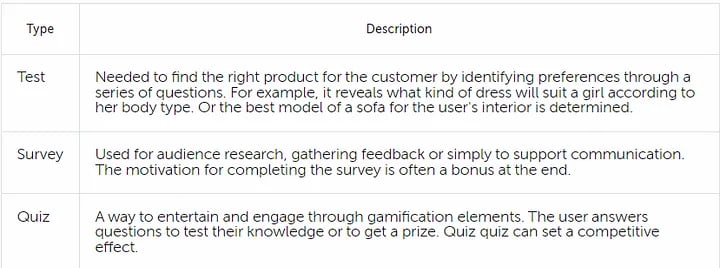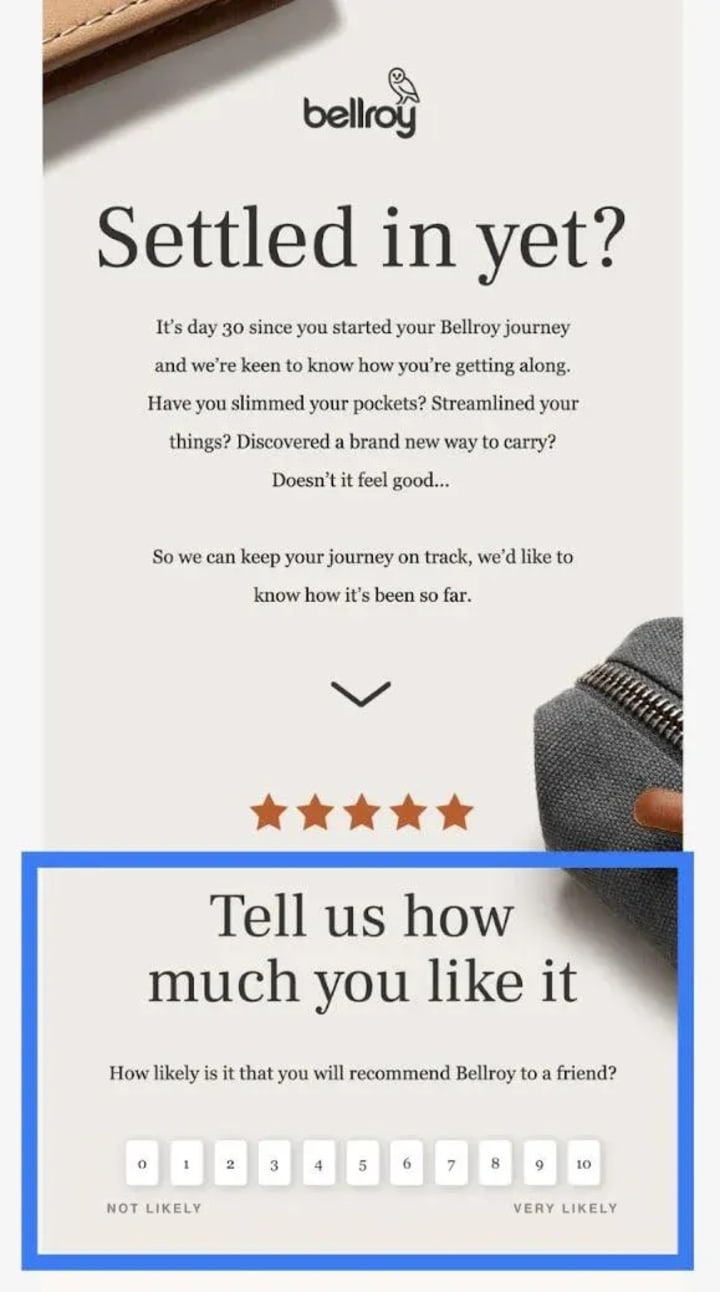Quiz as a Tool in Digital Marketing
Quiz as a Tool in Digital Marketing: Definition & Advantages

To attract and engage audiences, marketers employ various tools and formats. It’s crucial for companies to stand out amidst competitors in the information flow and draw attention to themselves.
Thanks to marketing technologies, interactivity is now available. One of the real-time ways to conduct marketing communications has become quizzes. It’s a simple and understandable format that serves marketing purposes. Advertising campaigns become non-trivial and more effective.
In this article, we’ll discuss what quizzes are, how quiz marketing benefits businesses, and how it works.
What is a quiz in marketing
A quiz in marketing is a promotional tool built on an interactive survey that provides a result at the end. The user answers questions one by one (usually in a multiple-choice test format), and at the end, they receive a description (for example, of their qualities) immediately or after providing an email address.
Quiz marketing works for selling products and services and is also used as a way to research the audience and gather feedback.
What quizzes are: examples

Additionally, quizzes are divided into:
- Entertainment quizzes: The goal of such quizzes is to evoke a smile and uplift mood rather than directly sell. These quizzes are created with humor, shared among friends, and their results are shared on social media. For example, after movie premieres, quizzes in the style of “which character from movie N are you?” appear.
- Educational quizzes: These are knowledge checks where users learn new facts. This type of quiz is beneficial for educational platforms. For instance, a foreign language school will likely offer a test to determine the student’s proficiency level.
- Sales-oriented (marketing) quizzes: An alternative to traditional online advertising packaged in an engaging format. Instead of directly suggesting, for example, choosing a sofa, a brand may offer a quiz to determine which option best suits the customer.
Each type can be called engaging because the user interacts with the content and explores it.
Advantages of quizzes
Quizzes are a full-fledged marketing tool that helps:
Collect leads and expand the company’s customer base. Users are more willing to leave their contacts to receive an answer after completing the quiz than just because.
Present their product or service in a non-standard way. A well-designed quiz is built around the brand’s product, presenting it not directly like in standard advertising but more organically. This format irritates the audience less and also entertains because of its humorous questions.
Explore potential or existing customers. Quiz responses not only provide answers to the customer (for example, regarding product selection) but also gather data about the audience’s preferences. Based on this information, segmentation is carried out.
Assist the sales department. Quiz advertising can perform managerial functions. The customer answers questions that a salesperson would typically ask to identify needs. However, this function is taken over by an online survey. Sales managers then use quiz data in their interactions with customers. Personalization is also involved because initial information about the customer is already available.
Save on customer acquisition. The cost of a lead generated from a quiz is often lower than from standard advertising. Launching such a format is cheaper than, for example, targeting, and there is also a chance that your quiz or trivia will go viral.
Engage users with content. Quizzes and surveys are interactive and unusual types of content that motivate people to stay on the brand’s page or in the application longer.
Where quizzes are placed
Quizzes are considered universal tools because they can be embedded on various platforms.
Website
The first option is to place the quiz on one of the web pages as a block or a separate window. The second option is to create the quiz in the form of a landing page that collects leads in an interactive format.
Social Media
Usually, social media platforms are chosen as a way to promote the quiz, which users access via a link to an external resource (website). However, there are options where quizzes are launched within social media platforms through internal applications (e.g., VKontakte).
Email Campaigns
Email serves as an advertisement for your quiz when users need to navigate to another page via a link or button. But with AMP technologies, there is an opportunity to take the quiz directly in the email and receive the results immediately.

How to create your own quiz
1. Set goals. Determine the marketing objective for which you need a quiz: lead generation, brand or product recognition, gathering information about customers, and so on. It’s essential to understand precisely why you’re using this format to avoid wasting resources.
2. Decide on the quiz topic, type, and platform for placement (see above for more details). The options should align with the goals you’ve set. It’s illogical to create just an entertaining text if you want to quickly acquire new leads because such an option is likely to work for virality.
3. Create content for each quiz block, which includes:
- Catchy headline and description. It’s crucial to grab the person’s attention and appeal to their interests because there won’t be a second chance. Don’t be afraid to get creative.
- Questions for the test/survey/quiz. Make them simple, understandable, and not time-consuming for the user. Illustrate them with pictures if appropriate.
Important! Don’t make the quiz too lengthy for people to complete it.
- Result form. Plan the content of the response after completing the quiz and the options for obtaining it: immediately on the screen or after the person leaves their email or phone number. To increase the quiz’s virality, it’s useful to add the option to share the results on their social media page.
4. Create the quiz in a reliable service. There are various options available that differ in features and price. For example, Marquiz, Flexbe, Madtest, Envybox, “Konversus,” and so on. These services offer sets of templates, interactive elements, design customization, and integration with analytics systems. There are free trial tariffs.
5. Test the quiz. Everything should work correctly, and errors in the text are unacceptable. A small technical issue can ruin the impression and make the user abandon the test.
6. Launch the quiz and analyze the results. Evaluate the effectiveness of the advertising campaign. For example, the number of leads added to your customer database. It’s also useful to assess user actions within the quiz itself: how many people started but didn’t finish, how many reached the middle and quit, and how many users successfully completed it. This is important for refining the content and future campaigns.
Mistakes in creating quizzes
Too many questions and their complexity. Your quiz should not tire the user or steal their time. Remember that it’s not an exam, so make the questions simple but not primitive.
Lack of benefit for the individual. If it’s unclear why someone should take the test, they simply won’t. It’s important to explain in the description what users will gain in the end: new self-knowledge, a beneficial offer, or a bonus from the company.
Lack of a result. Even if you’re gathering feedback for yourself, provide a symbolic description of the user’s status. For example, assign them a level in your company’s hierarchy like first, second, and so on.
Summary
A quiz is an interactive format of tests, surveys, and quizzes that works in marketing to attract new customers, engage users, study the audience, and increase sales. Such formats are placed on the brand’s website, a separate landing page, on social media, and offered to subscribers via email. Quizzes can be entertaining, educational, and sales-oriented. Each type addresses different business objectives.
Quiz marketing is a simple way to make content non-trivial. Tests are created in specialized services and added to brand platforms. To create a quiz, you need to set a goal, come up with a catchy headline and description, plan the content (questions and their quantity). Then, check the questionnaire’s correctness and launch it for the audience.
The article was originally published here.
About the Creator
Altcraft
Interesting and useful articles about marketing, our product and online communications
Enjoyed the story? Support the Creator.
Subscribe for free to receive all their stories in your feed. You could also pledge your support or give them a one-off tip, letting them know you appreciate their work.






Comments
There are no comments for this story
Be the first to respond and start the conversation.